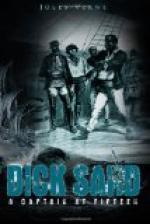Finally, it was, indeed, the roaring of the lion that had just sounded through the forest! And those forks, those chains, that knife of singular form, they were the tools of the slave-trader! Those mutilated hands, they were the hands of captives!
The Portuguese Negoro, and the American Harris, must be in collusion! And those terrible words guessed by Dick Sand, finally escaped his lips:
“Africa! Equatorial Africa! Africa of the slave-trade and the slaves!”
End of Part I
PART II
* * * * *
CHAPTER I.
THE SLAVE TRADE.
The slave trade! Nobody is ignorant of the significance of this word, which should never have found a place in human language. This abominable traffic, for a long time practised to the profit of the European nations which possessed colonies beyond the sea, has been already forbidden for many years. Meanwhile it is always going on a large scale, and principally in Central Africa. Even in this nineteenth century the signature of a few States, calling themselves Christians, are still missing from the Act for the Abolition of Slavery.
We might believe that the trade is no longer carried on; that this buying and this selling of human creatures has ceased: it is not so, and that is what the reader must know if he wishes to become more deeply interested in the second part of this history. He must learn what these men-hunts actually are still, these hunts which threaten to depopulate a whole continent for the maintenance of a few slave colonies; where and how these barbarous captures are executed; how much blood they cost; how they provoke incendiarism and pillage; finally, for whose profit they are made.
It is in the fifteenth century only that we see the trade in blacks carried on for the first time. Behold under what circumstances it was established:
The Mussulmans, after being expelled from Spain, took refuge beyond the Strait on the coast of Africa. The Portuguese, who then occupied that part of the coast, pursued them with fury. A certain number of those fugitives were made prisoners and brought back to Portugal. Reduced to slavery, they constituted the first nucleus of African slaves which has been formed in Western Europe since the Christian Era.
But those Mussulmans belonged, for the most part, to rich families, who wished to buy them back for gold. The Portuguese refused to accept a ransom, however large it might be. They had only to make foreign gold. What they lacked were the arms so indispensable then for the work of the growing colonies, and, to say it all, the arms of the slave.
The Mussulman families, being unable to buy back their captive relatives, then offered to exchange them for a much larger number of black Africans, whom it was only too easy to carry off. The offer was accepted by the Portuguese, who found that exchange to their advantage, and thus the slave trade was founded in Europe.




